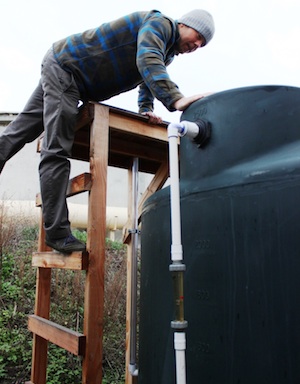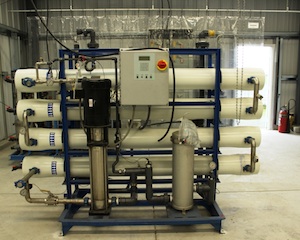Last November, professor emeritus Alan Richards gave a “pub talk” at the Red Room downtown titled “Petrol Politics in the Wake of Arab Spring.” Oil gets more flack than it deserves for causing wars, he said. Another real yet less talked about issue in the Middle East is water.
Things aren’t so different on this side of the globe.
From the desalination debate in Santa Cruz and “Food Grows Where Water Flows” signs posted throughout the central valley, California water policy gets a captive audience.
So if water is precious enough to cause tension in the Middle East and panic in California’s agricultural sector, and if unfiltered, untreated water carries agricultural nutrients that can harm the ocean’s ecology, why is so much of it piped into the ocean every day?
To explore this question and learn about UCSC’s Center for Integrated Water Research and their water research facility in Watsonville, “WaterLab,” I spoke with environmental engineer Eli Weintraub last month. Weintraub, who specializes in water treatment technologies, received a Masters degree from UC Davis 8 years ago, and has been working on WaterLab since 2009.
“It’s a matter of money,” Weintraub said. “There’s laws that say what level you have to treat water to before you put it in the ocean. It would cost more to do tertiary treatment.”
A tertiary filtration step allows “non-potable” water to be piped back for use in the agricultural sector. In contrast, non-recycled wastewater just goes through two treatment steps before it is piped out to the Monterey Bay from Watsonville.
That water contains nitrates and phosphates gathered from agricultural fields. To filter all wastewater a third time, however, would please neither producers nor consumers in the area.
“Martinelli’s wouldn’t be stoked,” Weintraub said, adding that neither would customers since the price of the Watsonville company’s drink products would sky rocket.
While there may be no reprieve for the per gallon nutrient load dumped in the bay anytime soon, there could be a reduction of the amount of nutrient-rich water if full-scale water recycling became a reality.
“In California it’s not legal to treat wastewater to the point of drinking water. It comes really close in some places but not exactly to that point,” Weintraub said. One of those places is San Diego (check out this article to learn more http://www.nytimes.com/2012/02/10/science/earth/despite-yuck-factor-treated-wastewater-used-for-drinking.html?pagewanted=all&_r=0).
Some places like El Paso, Texas return wastewater to the water supply after many treatment steps, but in California, it is first reintroduced to a natural conveyance or storage, such as an aquifer, before it can be reintroduced as drinking water. Mostly we throw it in the ocean.
If it reaches its full potential, WaterLab might help revise that waste paradigm by illustrating the viability of water recycling technologies.
Research at WaterLab
The purpose of WaterLab is to be a hub for water treatment research that international researchers can utilize. Unlike the small lab setting most researchers are confined to, WaterLab plans to offer researchers a permanent, pilot scale water research facility.
“The final goal is to have a fully operating pilot scale water recycling plant,” Weintraub said, adding that it has already received interest from researchers internationally. And the equipment is still dry.
In addition to access to wastewater, WaterLab has two filtration systems built so far. The first is a slow-sand-filtration system that relies on gravity for energy: wastewater is piped in near the top of a tank partially filled with sand. The sand filters out larger molecules, leaving cleaner water to be released from a spigot near the bottom. Such a simple technology might seem like the answer to the world’s water woes, but it requires a lot of space. Therefore it is only practical when large amounts of land are available that can be dedicated to the filtration process.
Secondly, the lab has a reverse osmosis machine. Reverse osmosis relies on electricity to pressurize water through a membrane, filtering out larger molecules. Like a French press coffee maker, once pressure is applied, the smaller molecules (of which water is the smallest) pass through to the other side leaving the solute on the original side. Depending on the experiment, secondary or tertiary water will be sent through the system after which water quality and energy consumption can be tested.
(For more on the various treatment steps and trends in water recycling, check out http://blogs.ei.columbia.edu/2011/04/04/from-wastewater-to-drinking-water/.)
Rather than working with raw sewage sludge, both systems will access water already treated by the Watsonville wastewater treatment system twice, at a minimum.
“We have the goal of creating a pilot scale system in here which is a bunch of really small scale treatment steps to (1) take that secondary water and treat it to tertiary and (2) also to take the tertiary water that we make and that we get from the plant and treat it another step further, which is RO (reverse osmosis), and that is, hopefully, drinkable.”
The amount and quality of the water, pressure, and runs will all be experimental factors for WaterLab researchers to play with.
“We have the luxury of not being required to do anything so we if we want to push the limits on something to see how it works we can.”
The research could also influence the desalination debate since the technology for desalination is similar, according to Weintraub.
“You’re treating unconventional water to a high standard. The same RO system could be used, slow sand filters also, and more of the equipment that’s coming is really similar.”
Interning at WaterLab
The lab is still being built, with a working reverse osmosis system and a slow sand filtration system (built by undergraduate interns). So far interns were brought on to learn about wastewater recycling and to contribute muscle power to build the treatment units, but those roles will shift and expand as the facility progresses.
“As it goes forward they’ll be helping test , operate, and research,” Weintraub said.
Perhaps internships would also involve environmental education down the road. Next door to WaterLab is a teaching facility where young students learn about water and conservation. Weintraub said it was no accident the two are side by side.
“Students can be brought over to learn about WaterLab too.”
Weintraub said the facility has already garnered international interest, adding, “And we’re not even pumping water through any of the equipment yet.”
“It could end up being a really unique thing.”
UCSC students can learn more about WaterLab and internships by contacting Eli Weintraub and via the Center for Integrated Water Research website.


